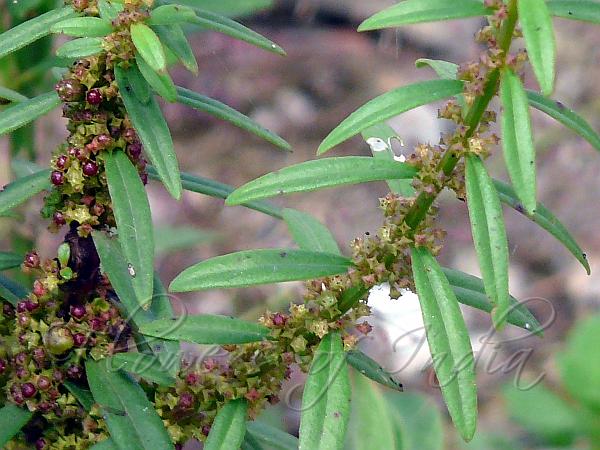|
| Blistering Ammannia |
|

|

| File size | 364340 |
| Original date | 9/27/08 2:08 PM |
| Resolution | 2048 x 1536 |
| Flash | Flash did not fire, auto |
| Focal length | 82.8mm |
| Exposure time | 1/250s |
| Aperture | 5.6 |
| Focus Distance | |
| Metering Mode | Multi-segment |
| Camera make | Panasonic |
| Camera model | DMC-FZ18 |
| Sensor type | OneChipColorArea |
|
|
|
|
Photo: |
Botanical name: Ammannia baccifera Family: Lythraceae (Crape Myrtle family)
Synonyms: Ammannia vescicatoria, Ammannia aegyptiaca
Synonyms: Ammannia vescicatoria, Ammannia aegyptiaca
Blistering Ammannia is an erect, branched, smooth, slender, annual herb,
found in open, damp, waste places. It is more or less purplish herb 10-50
cm in height, with somewhat 4-angled stems. The leaves are narrow-oblong,
oblanceshaped, or narrowly elliptic, about 3.5 cm long - those on the
branches very numerous, small, and 1-1.5 cm long – with narrowed base and
pointed or somewhat rounded tip. The flowers are small, about 1.2 mm long,
greenish or purplish, and borne in dense clusters in leaf axils. The
capsules are nearly spherical, depressed, about 1.2 mm in diameter, purple.
The seeds are black. The common name comes from the fact that the leaves
are exceedingly acrid, irritant, and vesicant, and are being used by the
village-folk to raise blisters, being applied to the skin for half an hour
or a little longer.
Medicinal uses: The leaves or the ashes of the plant, mixed
with oil, are applied to cure herpetic eruptions. The fresh, bruised
leaves have been used in skin diseases as a rubefacient and as an external
remedy for ringworm and parasitic skin affection.
The leaves or the ashes of the plant, mixed
with oil, are applied to cure herpetic eruptions. The fresh, bruised
leaves have been used in skin diseases as a rubefacient and as an external
remedy for ringworm and parasitic skin affection.
Medicinal uses:
 The leaves or the ashes of the plant, mixed
with oil, are applied to cure herpetic eruptions. The fresh, bruised
leaves have been used in skin diseases as a rubefacient and as an external
remedy for ringworm and parasitic skin affection.
The leaves or the ashes of the plant, mixed
with oil, are applied to cure herpetic eruptions. The fresh, bruised
leaves have been used in skin diseases as a rubefacient and as an external
remedy for ringworm and parasitic skin affection. | Identification credit: Dinesh Valke, Gurcharan Singh | Photographed at Vaghbil, Thane, Maharashtra. |
• Is this flower misidentified? If yes,